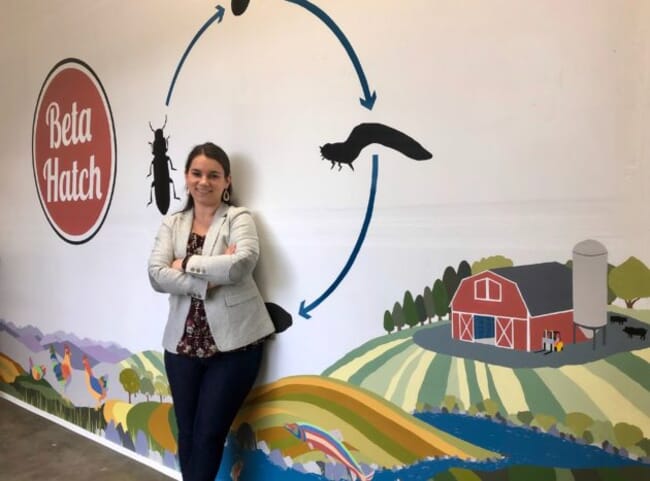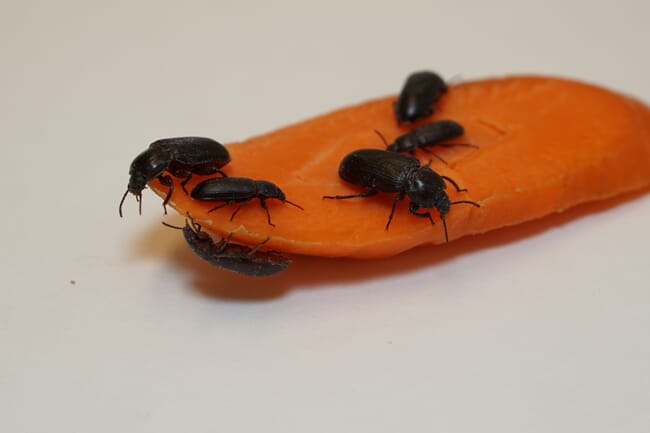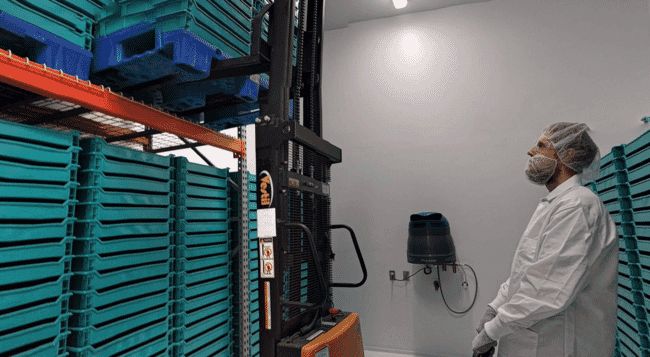
“As an entomologist you spend 99 percent of your time trying to kill bugs [developing pesticides]. I wanted to find a way to include them in the food system – they are, after all, the basis of most food chains,” explains Emery.
Emery, who has a PhD in insect genetics and chemical communication, began to experiment with breeding insects while at college. She was soon, she chuckles – not without pride – being referred to as “The Bug Lady” around her neighbourhood, in Washington State.
While similar breeding programmes were underway in other parts of North America, most of these were using larvae of the black soldier fly.
“Mealworms are slower growing, but they are adapted to a dry feed so can be grown at higher density, which means they produce a similar volume of the end product – insect meal and insect oil – to black soldier flies. The protein quality and fat content are also higher for mealworm products in general," she explains.

© Dana Robinson
In the five years since she started her breeding programme Emery has made substantial progress.
“We've cut the development time to a quarter of what it was when we started, meaning the larvae are ready to harvest within eight weeks. Our females are now producing twice the number of eggs and we’ve also done a lot of breeding for size research,” she explains.
Although she started the breeding programme using traditional family selection techniques, over the last 18 months she has combined these with genomics – research that has now allowed her to sequence the entire mealworm genome.
And she is hoping that this work will be of value both to Beta Hatch and to the wider insect-growing community.
“We’re publishing the results in the Journal of Insects as Food and Feed later this summer. It’s going to be an open access publication as we want to encourage more research into the species.”
“The genome now needs to be interpreted and we'd like to see the research of others accelerate the growth of the whole insect industry. We also think there's a need to establish national insect laboratories, in both the private and public sectors, to conduct further research into this area,” Emery explains.
Raising a $3 million investment during the outbreak of the COVID-19 pandemic is no mean feat for a start-up and Emery has had other priorities to factor in too.
“The pandemic made it tough – in fact it made us decide to renegotiate terms – to ensure we secured the funding. And my first child was born in January, so it’s been an interesting few months,” Emery reflects.
However, she believes that establishing a pilot facility with their previous funding round made a crucial difference.
“Investors want to see operational facilities before they invest, so it was very valuable that we'd already developed a pre-commercial facility with our seed funding,” she explains
Emery also points to the wider interest in the use of insects by some of the largest aquafeed producers on the planet.
“It helps that there's lots of interest in this space at the moment – Skretting and Cargill are both looking into investing in insects – and we appealed to Wilbur Ellis [one of the main sources of the $3 million investment], as they’ve already made a number of aquaculture investments, so understand the sector,” explains Emery.
“And all our investors have shown huge support for our business model – in many ways it makes more sense than ever now, as the pandemic has highlighted the need for changes in the food supply chain,” she adds.

Once it’s up and running Beta Hatch’s new facility have the capacity to produce a tonne of mealworms a day, making it the largest producer of the species for animal feed in North America. The continent’s only two bigger producers in the space - Enterra in Canada and Enviroflight in Kentucky – are both involved in black soldier fly production.
However, all three are dwarfed by the scale of some of Europe’s more established insect producers, such as Ynsect and Protix.
“We're a few years behind Europe, in part because American investors have been behind the times. I think the US investment market is missing out – partially because of a bias towards software businesses,” Emery reflects.
However, despite this, she believes that there’s plenty of scope for Beta Hatch to grow.
There's lots of interest and we're looking to expand nationally. Post-pandemic I think we're going to see more investments in the food system sector – everyone wants diversity of food production I think we're going to see more investment dollars into the sector,” she predicts.
In the meantime, Emery – despite being thrilled to have achieved so much – is looking to continue developing.
“We now have 14 full-time staff and we're working to expand. Having been breeding bugs in my backyard not so long ago it's really exciting to think they were soon going to have a 30,000 square foot semi-automated facility which will even be designed to allow for social distancing between our workers. The challenge for us now is to scale up and reduce the cost of production,” she concludes.


